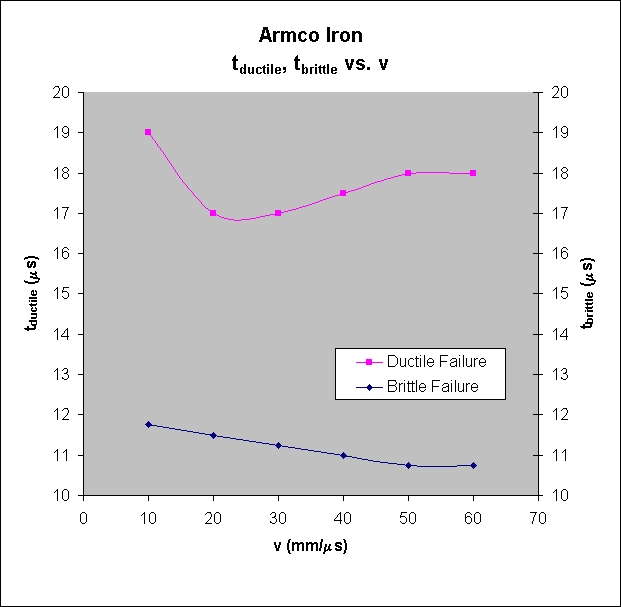Projectile impact speed was treated as an experimental variable. Values tested include 10, 20, 30, 40, 50, and 60 mm/ms. For each speed, graphs of maximum principal stress vs. time and and effective stress vs. time were analyzed. Time 0 corresponds to the instant of impact. Conclusions on brittle failure time were made from analysis of the maximum principal stress vs. time graph. Brittle failure was assumed to occur for a maximum principal stress having value:s = 2[A + B(ep)n] where ep = 0.2%
For armco iron, this yield stress value is 0.5690 mg/mm-ms. The first time for which the maximum principal stress reached this value for any one of eight elements analyzed from the mesh of the thin plate was recorded as the time for brittle failure. Time for ductile failure was found from analysis of the effective stress histogram. Ductile failure is assumed to occur when the effective stress of an element of the thin plate drops to 90% of the peak value, for that element, reached. Thus, the first time for which a 90% drop from the maximum occurs for effective stress of any one of eight elements from the mesh analyzed is the time of ductile failure. After collecting times of brittle and ductile failure for the six speeds tested, the brittle failure time and ductile failure time were plotted against impact speed. The results of stress histogram analysis are tabulated below. The time for ductile failure and time for brittle failure vs. impact velocity graph for armco iron is also presented below.
Failure Analysis Results Ductile Failure Brittle Failure Velocity (mm/ms) Time (ms) Mesh Element # Time (ms) Mesh Element # 10 19.00 112 11.75 37 20 17.00 112 11.50 37 30 17.00 112 11.25 43 40 17.50 112 11.00 37 50 18.00 112 10.75 ** 60 18.00 ** 10.75 ** ** Mesh element numbers where difficult to determine in analyzing stress histograms due to curves being very close to one another.
The critical velocity, according to Kalthoff, is where time of ductile failure and time of brittle failure are equal. However, for armco iron, the time of ductile failure curve and time of brittle failure curve do not intersect in the range of velocities tested. Thus, no conclusions can be drawn about a so-called critical velocity for armco iron for the conditions of our experiment. In the range of velocities tested, armco iron always undergoes brittle failure before ductile failure. The least time duration between brittle failure and subsequent ductile failure appears to be approximately 5.5 ms at approximately 24 mm/ms. The general trend of the curves does not indicate that the curves may intersect at a velocity close to the minimum and maximum velocities tested. However, it may not be stated that the curves never intersect. The curves may drastically change at velocities greater than 60 mm/ms. Impact velocities below 10 mm/ms will take longer to cause failure, and as the velocity approaches 0, failure is less and less likely to occur. Brittle failure typically occurred at element 37 of the thin plate mesh which is at approximately 45° above the notch axis turned about the center of the notch fillet. Ductile failure most frequently occurred at element 112 which is at approximately 15° below the notch axis turned about the center of the notch fillet.
